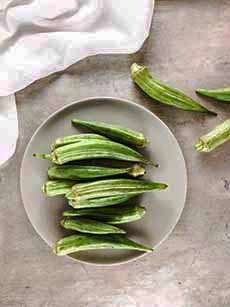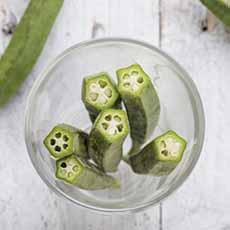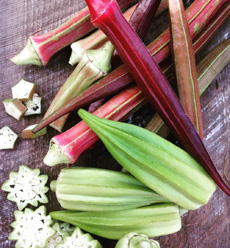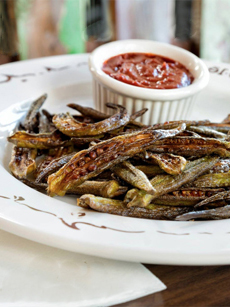TIP OF THE DAY: Okra’s In Season, What Should You Cook?
|
Most people think of gumbo as a soup or stew from Louisiana, typically made with chicken or shellfish, Andouille sausage, bell peppers, celery, and onions, and thickened with okra pods. But in the beginning, “gumbo” was simply the word for okra in the African Bantu language. Okra came to America with the slave trade and was introduced to the Southern white population by their African cooks. Okra became the vegetable associated with the American South*. Okra is a flowering plant in the mallow family, Malvaceae, which also includes cacao, cotton, hibiscus, the kola nut (the base flavor of cola drinks) and the “king of Asian fruits,” the durian, known for its strong aroma and large, thorny husk. The valuable part of the okra plant is its edible green seed pods. The geographical origin of okra is disputed, with champions of Ethiopian, West Africa, and even South Asia. Today, the vegetable is cultivated in tropical, subtropical, and warm temperate regions around the world. [Ssource] Okra is used in casseroles, soups, stews, and sides; added, cooked, to salads and sandwiches (try an okra grilled cheese). It can be fried or stuffed (like poppers). June is National Okra Month. *Okra is also an important ingredient in cuisines in areas as far-flung as Africa, Asia, and Latin America. We consulted the experts on the best ways to use okra. Here are Southern Living’s recommendations for the 12 best okra recipes: We looked into THE NIBBLE archives and found: Flavor Infused Broth Some people avoid okra because of its “slimy” texture. That okra just hasn’t been cooked correctly. Here are slime-busting tips from Okra, a Savor the South cookbook by Virginia Willis.: Okra (Abelmoschus esculentus) is a vegetable with edible seed pods in the hibiscus/mallow family† (Malvaceae). The plant is of disputed origin. No truly wild form has been found, which botanists use to establish origin. Different scientists suggest Southeast Asian, South Asian, Ethiopian, and West African origins [source]. In the 12th and 13th centuries, Egyptians and Moors (Muslims of the Iberian Peninsula) used the Arabic word for the plant, bamya, suggesting it had come into Egypt from Arabia, but that earlier it was probably taken from Ethiopia to Arabia. One of the earliest European accounts of the vegetable is from a Spanish Moor who visited Egypt in 1216 and described the plant under cultivation by the locals who ate the tender, young pods with their meals. Regardless, it was from Arabia that the plant spread to the other shores of the Mediterranean Sea and eastward. It became a staple food in parts of Africa. Okra was introduced to the Americas by ships plying the transatlantic slave trade. Some African women were able to braid okra seeds into their hair before being forced aboard slave ships [source]. The plant is documented in Brazil by 1658, and in Suriname in 1686. Okra may have been introduced to southeastern North America from Africa in the early 18th century. By 1748, it was being grown as far north as Philadelphia. Thomas Jefferson noted that cultivation was well established in Virginia by 1781, and it was commonplace throughout the South by 1800. Because of its slimy interior, okra was first used by slave owners to thicken soups. Gumbo, the Créole name for okra, developed in Louisiana. The Creole name derived from the Bantu language spoken by Angolan slaves, ngombo. Though its history in America is unfortunate, it has become a staple ingredient in the Southern U.S. If you’d like to make it at home, fried, grilled, or pickled okra are easy options. |
[3] Okra pods were originally green, but mutations have led to the development of red and burgundy varieties. Look for them in your farmers’ market (photo © Starling Yards).
|
|
|
________________ †In addition to okra, well-known members of the Malvaceae family include cacao, cotton, durian, hibiscus, and sorrel. CHECK OUT WHAT’S HAPPENING ON OUR HOME PAGE, THENIBBLE.COM.
|
||








